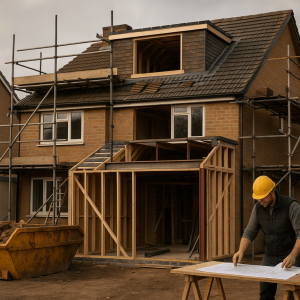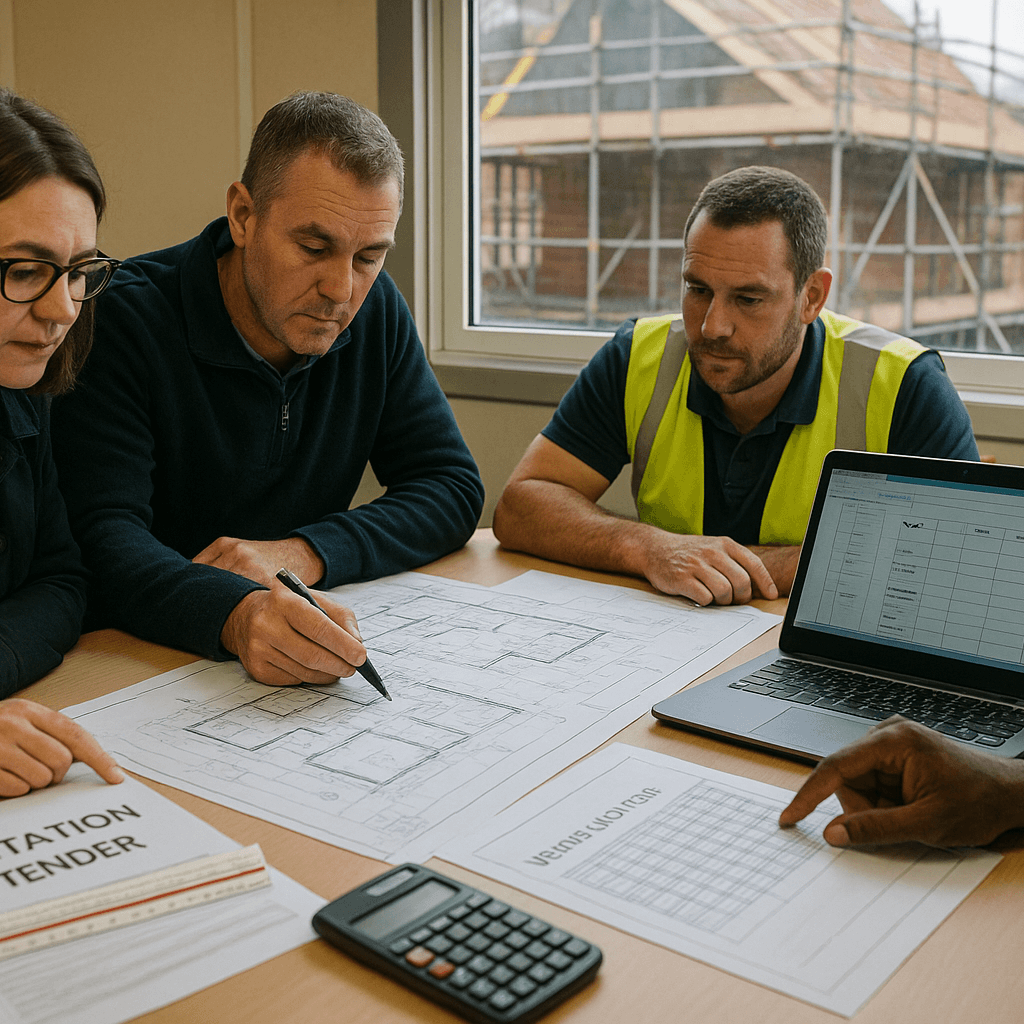Material Price Indices and Inflation Trends
Essential to knowing where prices are headed and managing cash flow in construction lies in the Material Price Indices. Let’s break down the main categories:
Aggregates
Think gravel, sand, and bitumen. These materials form the foundation of many construction projects, from roads to buildings. Fluctuations in the prices of these materials can significantly impact project costs.
Cement and Concrete
From the ubiquitous ready-mixed concrete to fibre cement, these materials are essential for structural integrity in construction projects. Price changes in this category can affect everything from small residential builds to large-scale infrastructure projects.
Clay Products
Such as bricks, tiles, and a spot of elegant ceramic sanitaryware. These materials are crucial for masonry and finishing work in construction.
Metal Products
All essentials, from central heating boilers to screws. Metal products are vital for both structural and finishing aspects of construction projects.
Plastic Products
Includes pipes and floor coverings. Plastic materials are often used for their durability and cost-effectiveness in various construction applications.
Timber
Covering plywood and particle board. Timber is a versatile construction material used in framing, flooring, and finishing.
Others
Plasterboard, paint, you name it! These miscellaneous materials are essential for the finishing touches on construction projects.
It’s been a bumpy ride with inflation, especially highlighted by the spikes during the 2021/22 pandemic. Interestingly, though the inflation cooled off post-pandemic, the prices themselves kept climbing.
Highlight on Major Price Changes
For a clearer picture, here are the year’s standout changes in material prices, from April 2023 to April 2024:
- Pipes and fittings: up by a striking 19.3%
- Metal doors and windows: increased by 17.7%
- Gravel, sand, clays, and kaolin: saw both rises and falls, illustrating the market’s volatility
- Concrete reinforcing bars and structural steel: notable decreases of as much as 22.7%
Bricks, Blocks, and Concrete Production – A Gauge of Demand
The volume of these essential building blocks tells us much about the industry’s heartbeat. Surprisingly, recent periods have seen some of the lowest outputs in two decades, further complicated by a steady rise in prices despite decreased demand.
The Balancing Act of Imports and Brexit
The Brexit saga has noticeably shifted where the UK turns for its building materials. China now ranks as a major supplier, outpacing traditional partners like Germany and Spain. This shift raises a curious dilemma about the sustainability and costs of reliance on imported goods.
Impacts on Supply Chain
Brexit has reshaped the supply chain landscape. Increased customs checks and import tariffs have altered the dynamics, potentially increasing lead times and costs.
Sustainability Concerns
The reliance on imports, especially from distant countries like China, raises questions about the environmental impact and long-term sustainability of sourcing practices.
Construction Output and Market Movement
Despite positive murmurings in the housing market, the overall construction output continues its downward trajectory. Even as house prices stabilise, the volume of new builds and commercial developments isn’t picking up speed as hoped.
Factors Influencing Output
Several factors contribute to the sluggish construction output:
- Economic Uncertainty: Ongoing economic uncertainties, including those related to Brexit and global market conditions, impact investor confidence and funding availability.
- Labour Shortages: A shortage of skilled labour continues to be a significant challenge, slowing down project timelines and increasing costs.
- Regulatory Changes: New regulations and compliance requirements can add complexity and delay project execution.
What’s the Deal with Construction Wages?
Even in a fluctuating market, wages within the construction sector have remained relatively stable. However, a surge in job vacancies points towards a growing demand for skilled labour, which could push wages up if the scarcity continues.
Labour Market Dynamics
The construction labour market is experiencing several dynamics:
- Skill Shortages: The demand for specialised skills in areas such as project management, engineering, and skilled trades is outpacing supply.
- Training and Apprenticeships: There is an increasing focus on training and apprenticeship programmes to bridge the skills gap and attract new talent to the industry.
- Wage Pressures: As demand for skilled labour grows, wages are likely to rise, impacting project budgets and overall industry costs.
Understanding the Dynamics of Construction Costs
Understanding the dynamics of construction costs and industry trends is crucial, whether you’re directly involved in the sector or planning a future project. While deflation in material prices offers a gleam of optimism, the real impacts on output and demand will determine the market’s resilience and future growth.
Key Cost Drivers
Several factors drive construction costs:
- Material Prices: Fluctuations in the prices of key materials such as steel, concrete, and timber significantly impact project costs.
- Labour Costs: Labour costs are a major component of construction budgets. Skilled labour shortages and wage pressures can drive costs higher.
- Regulatory Compliance: Compliance with new regulations and standards can add to project costs, particularly in areas such as safety and environmental sustainability.
Strategies for Cost Management
Effective cost management strategies are essential for navigating the complexities of the construction market:
- Early Planning: Detailed early planning helps to identify potential cost drivers and develop strategies to mitigate them.
- Value Engineering: This approach involves finding cost-effective alternatives to traditional construction methods and materials without compromising on quality.
- Technology Adoption: Leveraging technology such as Building Information Modelling (BIM) can improve project planning, coordination, and cost control.
Examining Specific Price Increases in 2024
Understanding the latest price increases in construction materials is crucial for effective project planning and cost management. Here are some specific price increases to be aware of in 2024:
- Insulation
- Kingspan: Kingspan Therma Range, Ecotherm Insulation Range increased by 7.50%
- Recticel: All PIR Insulation increased by 8.00%
- Actis: All Products increased by 3.00%
- Celotex: All Products increased by 8.00%
- Xtratherm: All PIR Insulation increased by 8.00%
- Recticel: All Insulation increased by 8.00%
- Isover: Isover Spacesaver range (loft roll), all other structural products, all Isover technical products increased by 9.00%
- Knauf: Knauf Insulation increased by 9.70%
- Celotex: All products increased by 10.00%
- Recticel: Insulation increased by 10.00%
- Unilin/Xtratherm: All PIR Insulation increased by 10.00%
- Kingspan: Kingspan Kooltherm Range increased by 2.00%
- Kingspan: EcoTherm Insulation PIR increased by 10.00%
- Kingspan: Kingspan Therma Range increased by 10.00%
- Celotex: All Celotex PIR products increased by 10.00%
- Plaster & Plasterboard
- Fermacell: Fibre Gypsum Boards increased by 4.00%
- Siniat: Siniat Vapour Boards increased by 4.9-5%
- Siniat: Siniat Performance Boards, Specialist Boards and Building Boards (Except Aqua boards and Weather Defence) increased by 5.70%
- Siniat: Siniat Acoustic Sealants and Cove increased by 3.7%
- Siniat: Siniat Plasterboard Accessories increased by 3.6-4.7%
- Siniat: Siniat Standard and Thermal Boards increased by 4.7%
- British Gypsum: BG Cove and Cornice increased by 3.4%
- British Gypsum: Gyprex, Gyptone and Rigitone tiles, boards and hatches increased by 3.4%
- British Gypsum: BG Plaster accessories, jointing, sealants and cove adhesive increased by 2.9%
- British Gypsum: BG Fixings and nailable plugs increased by 5.0%
- British Gypsum: BG Plasterboard (Standard & Performance) and Plaster products increased by 3.4%
- Rockfon: Rockfon Stone Wool Ceiling Products (excluding Monoacoustic, Eclipse Islands, Canva, Lamella, Hub & Senses ranges) increased by 5.0%
- Knauf: Knauf Drywall Aquapanel boards and accessories increased by 3.50%
- Knauf: Knauf Drywall Powder jointing products increased by 3.00%
- Knauf: Knauf Drywall Plasterboard Adhesive (bonding compound) increased by 3.00%
- Knauf: Knauf Drywall Plasterboard (Standard & Performance) increased by 4.50%
- Roofing
- Velux: All windows increased by 10.00%
- Decking
- Cladco: All Cladco decking products increased by 10.00%
- Building Materials
- Weber: Render and other cement products increased by 5-10%
- Ceilings
- Zentia: All Mineral Tiles increased by 6.00%Flooring
- CFS Flooring: Floor tiles increased by 2.00%
In Conclusion
Understanding the dynamics of construction costs and industry trends is crucial, whether you’re directly involved in the sector or planning a future project. While deflation in material prices offers a gleam of optimism, the real impacts on output and demand will determine the market’s resilience and future growth.
Frequently Asked Questions About UK Construction Costs
What are the implications of falling construction material prices?
This could signal a potential relief for project costs but also reflect broader economic pressures. It’s important to consider the overall economic context when interpreting these price trends.
Is now a good time to start a construction project in the UK?
With stabilising prices and hopeful market signs, it might be a strategic moment to plan new developments. However, it’s crucial to conduct thorough market analysis and risk assessment before proceeding.
How can fluctuations in material costs affect my upcoming construction project?
Variations can influence overall budgets, potentially making projects more costly or, conversely, more affordable. Effective cost management and contingency planning are essential to mitigate these risks.
What should I consider when planning a construction budget?
Factor in potential price volatility and always have a contingency of around 10-15% to accommodate unforeseen expenses. Regularly review and update the budget to reflect current market conditions.
How do import changes post-Brexit affect UK construction?
Increased dependency on non-EU suppliers might offer cost benefits but also poses risks related to supply chain disruptions and quality variance. It’s important to diversify suppliers and develop robust supply chain strategies.
What trends are affecting the UK construction labour market?
A noticeable labour shortage is escalating the demand for skilled workers, potentially driving up wages. Investing in training and apprenticeships is crucial to address this skills gap.
How is the commercial construction sector performing?
Current indicators suggest sluggish growth, heavily impacted by economic and regulatory uncertainties. Strategic planning and investment in innovation can help navigate these challenges.
What long-term impacts could the current construction trends have on the UK economy?
Construction is a significant economic engine, and its health directly influences broader economic stability and growth. The industry’s performance can impact employment, GDP, and overall economic resilience.











